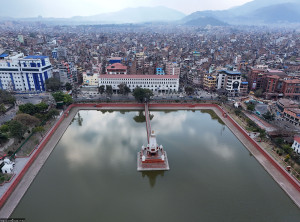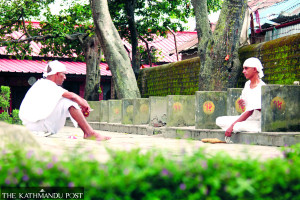Opinion
The Rohingya in Nepal
Any further influx of these refugees would pose a serious threat to the country’s sovereignty, but the country should still protect the ones that are already here..jpg&w=900&height=601)
Prasanna Mahat
The atrocities committed against the Rohingya in Myanmar are very well known as is the fact that, as a consequence of their persecution in Myanmar, they have been compelled to flee to neighbouring countries including Bangladesh, India and Nepal.
There are approximately 300 Rohingya living in Kathmandu, specifically in the Kapan area; and reports state that around 600 more are scattered all over Nepal. However, the exact number of these asylum seekers is not known. The reason why the Rohingya are entering Nepal may be because the living conditions for them in Nepal are far better than in India or other nearby states.
In 2012, in India, fear spread among right-wing politicians on account of the Bengali migrants in Assam, and Pakistan was planning to revoke the refugee status of all Afghans living within its borders. As a result, Bangladesh resolved to shut its borders to the fleeing refugees from Myanmar, instigating violence in Rakhine state. Nepal would then seem a naturally better choice for these refugees to settle in. Nepal was already home to around 800,000 refugees and asylum seekers in December 2013. But being one of the poorest countries in the world, this number is already more than what the government can handle.
Legal obligation
Nepal is not a signatory to either the 1951 Convention Relating to the Status of Refugees or the 1967 Protocol; it also does not have separate domestic refugee legislation, yet it continues to hold a large number of refugees. This can be seen as an act of humanity by the government, as Nepal is not duty-bound to act as per the convention since it has not ratified it.
With Nepal already hosting thousands of refugees and asylum seekers, a further influx may only create more problems like security threats, other contraventions in the labour market, misuse of land and so on.
Although Nepal has not ratified the 1951 Refugee Convention or the 1967 Protocol, it has ratified other human rights treaties such as the Universal Declaration of Human Rights and is subject to international customary laws. Article 14 (1) of the declaration states that everyone has the right to seek and enjoy asylum from persecution in other countries. This essentially means that the Rohingya have a right to seek asylum in Nepal, although it is not necessary that they must be granted refugee status. Forcefully deporting all Rohingya refugees would be a violation of this article of the Universal Declaration of Human Rights.
The Nepal government must also take into consideration the human rights violations suffered by these refugees, and how deporting them all at once would be a human rights violation. Customary international laws also play a major role in this scenario. The Principle of Non-Refoulement, a principle of customary international law, prohibits rejection of a refugee at the frontier and expulsion of refugees who have entered the country. It is the principle enshrined in Article 33 (1) of the Refugee Convention which says, ‘No Contracting State shall expel or return (“refouler”) a refugee in any manner whatsoever to the frontiers of territories where his life or freedom would be threatened on account of his race, religion, nationality membership of a particular social group or political opinion.’
However, this principle is now more than just a mere provision provided by the convention. It has now solidified into a general human rights requirement both at the universal and regional level, is read as protection covering all individuals who have left their homeland because of a substantial fear of persecution for reasons specified by the 1951 Geneva Convention in addition to those that would face inhumane treatment after repatriation. This principle would be applicable in the case of Nepal and the Rohingya as well.
Logical step
It would be best for Nepal to not take an extremist approach, and aim at deporting the Rohingya all at once in a similar fashion as the Indian government is trying to do. From a human rights perspective, the Rohingya that are already here are Nepal’s responsibility. At the same time, however, an increase in the influx of Rohingya refugees would also pose a serious threat to Nepal’s sovereignty and further burden the government.
Since Nepal already harbours a huge number of refugees, the government should not accept any more Rohingya. This will pose a huge challenge though, as Nepal has an open border with India. Security at the border should be strengthened. The Indian government is in motion to deport all the Rohingya from India, and Bangladesh has already closed its border to these refugees. It is very likely that they will come to Nepal to seek refuge. The government must try their level best to prevent this, maybe even put forward this issue to the Indian government.
As for the ones that are already in Nepal, the government must work out a rational solution for these asylum seekers, such as a waiver of the fines that the government imposes on all illegal immigrants. As is known, most of the refugees in Nepal are among the poorest people in the country. Being asylum seekers, they do not have work permits, and imposing fines on them would further decrease the chances of them leaving the country Hence, the government needs to conduct an assessment of the current number of Rohingya residing in Nepal, in order to get them resettled. But the main question here would be where, as neighbouring countries already host a large number. In this scenario, Nepal’s best bet would be willing states in the West.
***
What do you think?
Dear reader, we’d like to hear from you. We regularly publish letters to the editor on contemporary issues or direct responses to something the Post has recently published. Please send your letters to [email protected] with "Letter to the Editor" in the subject line. Please include your name, location, and a contact address so one of our editors can reach out to you.




 20.51°C Kathmandu
20.51°C Kathmandu




.jpg&w=200&height=120)





